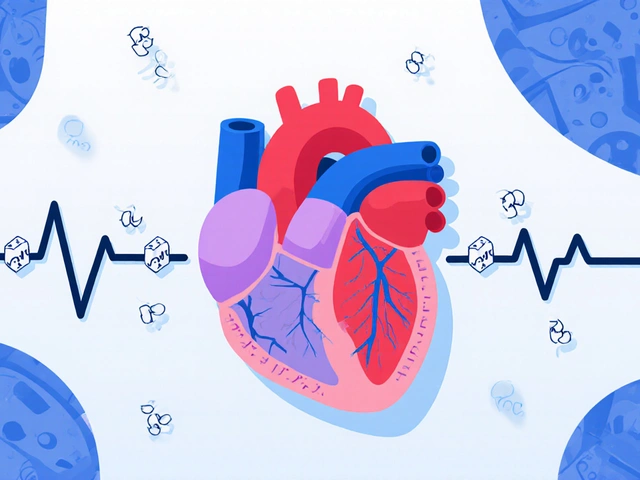When your heart skips, races, or flutters out of rhythm, doctors often turn to antiarrhythmic drugs to restore normal beats. Among these, verapamil is one of the most commonly prescribed - but is it the best choice for you? It’s not just about what works in theory. Real-world outcomes, side effects, and how it stacks up against other drugs make all the difference.
What is verapamil and how does it work?
Verapamil is a calcium channel blocker. That means it slows down the flow of calcium into heart and blood vessel cells. Less calcium means slower electrical signals in the heart, which helps control fast or irregular heartbeats - especially those starting in the upper chambers, like atrial fibrillation or supraventricular tachycardia.
Unlike some other antiarrhythmics that target sodium or potassium channels, verapamil works on calcium. This makes it especially useful for heart rates that are too fast but still regular in pattern. It’s often used in emergencies to stop a sudden racing heart, and it’s also taken daily as a long-term treatment.
It’s not a cure. It doesn’t fix the underlying cause of the arrhythmia. But it does give your heart a steadier rhythm, reducing symptoms like dizziness, shortness of breath, and chest tightness.
How verapamil compares to other common antiarrhythmics
There are four main classes of antiarrhythmic drugs, based on how they affect heart cells. Verapamil falls into Class IV - calcium channel blockers. Here’s how it stacks up against the others:
| Drug | Class | Primary Use | Common Side Effects | Key Limitations |
|---|---|---|---|---|
| Verapamil | IV (Calcium Channel Blocker) | SVT, atrial fibrillation | Constipation, dizziness, low blood pressure | Not for heart failure or severe LV dysfunction |
| Amiodarone | III (Potassium Channel Blocker) | Atrial fibrillation, ventricular tachycardia | Thyroid issues, lung scarring, skin discoloration | Long-term toxicity; requires regular blood tests |
| Flecainide | Ic (Sodium Channel Blocker) | SVT, atrial fibrillation | Visual disturbances, nausea, new arrhythmias | Contraindicated in heart disease or past heart attack |
| Metoprolol | II (Beta Blocker) | Rate control in atrial fibrillation | Fatigue, cold hands, sleep problems | Less effective at restoring normal rhythm |
| Digoxin | Unclassified | Rate control in elderly patients | Nausea, confusion, visual halos | Narrow therapeutic window; toxic easily |
Verapamil is faster-acting than digoxin and safer long-term than amiodarone. But it’s not as powerful as flecainide at converting atrial fibrillation back to normal rhythm. And unlike beta blockers like metoprolol, it doesn’t reduce heart rate by blocking adrenaline - it directly slows the heart’s internal pacemaker.
When is verapamil the best choice?
Verapamil shines in specific situations:
- You have paroxysmal supraventricular tachycardia (PSVT) - a sudden, rapid heartbeat that starts and stops on its own. Verapamil can stop it within minutes when given intravenously.
- You’re older and can’t tolerate beta blockers due to asthma or severe fatigue.
- You have high blood pressure along with your arrhythmia - verapamil treats both.
- You’re looking for an oral option that doesn’t require frequent lab monitoring (unlike amiodarone or digoxin).
It’s often the first-line drug for young, otherwise healthy people with SVT. In fact, studies show it successfully stops episodes in over 90% of cases when given early.
When you should avoid verapamil
Not everyone can take it. There are serious red flags:
- Heart failure with reduced pumping ability (ejection fraction below 40%) - verapamil can make it worse.
- Second- or third-degree heart block without a pacemaker - it can cause your heart to stop.
- Low blood pressure that’s already borderline - it can drop too low.
- Combining it with beta blockers like metoprolol - this combo can dangerously slow your heart rate.
Also, if you’re taking statins like simvastatin, verapamil can raise their levels in your blood, increasing the risk of muscle damage. Your doctor needs to know every medication you’re on - including over-the-counter supplements.
Real-life trade-offs: What patients actually experience
One 68-year-old woman in Bristol with paroxysmal atrial fibrillation switched from metoprolol to verapamil after constant fatigue and cold hands. Her heart rate stabilized, but she started having severe constipation - something her doctor didn’t warn her about. She now takes fiber supplements daily and drinks more water.
Another patient, a 42-year-old runner, had SVT episodes during training. After one IV dose of verapamil in the ER, his episodes dropped from weekly to once every six months. He’s been on it for three years with no major side effects.
These aren’t rare cases. The difference often comes down to how your body handles the drug. Some people tolerate verapamil perfectly. Others can’t get past the dizziness or digestive issues.
What about newer drugs?
Newer options like dronedarone and propafenone exist, but they’re not always better. Dronedarone has fewer long-term side effects than amiodarone, but it’s less effective and still risky for people with heart failure. Propafenone works well for rhythm control, but it’s not safe if you’ve ever had a heart attack.
Verapamil, despite being around since the 1970s, still holds its ground. It’s affordable, widely available, and has decades of real-world data behind it. In the UK’s NHS guidelines, it’s listed as a first-choice agent for SVT and rate control in atrial fibrillation - especially when beta blockers aren’t suitable.
How to know if verapamil is right for you
Ask yourself these questions:
- Do I have a fast, regular heartbeat that starts suddenly? (That’s SVT - verapamil is ideal.)
- Do I have heart failure, low blood pressure, or a slow heart rate already? (Then avoid it.)
- Am I on other meds that could interact? (Check with your pharmacist.)
- Can I handle mild constipation or dizziness? (It’s common - but not everyone can tolerate it.)
Your doctor will likely start you on a low dose - maybe 80 mg once or twice a day - and adjust based on your response and blood pressure. It can take weeks to find the sweet spot.
Final thoughts: Verapamil isn’t the only option - but it’s often the smart one
There’s no single best antiarrhythmic drug. The right choice depends on your heart’s specific problem, your other health conditions, and how your body reacts. Verapamil isn’t perfect. It doesn’t work for every type of arrhythmia. But for many people - especially those with supraventricular rhythms - it’s simple, effective, and safer than the alternatives.
If you’ve been told you need a rhythm drug, ask your doctor: "Is verapamil right for my type of arrhythmia? What are the alternatives? And what side effects should I watch for?" Don’t assume one drug is better just because it’s newer. Sometimes, the old standby is still the best fit.
Can verapamil cure arrhythmias?
No, verapamil doesn’t cure arrhythmias. It controls the rhythm by slowing down electrical signals in the heart. It helps manage symptoms and prevent episodes, but the underlying cause - like faulty heart tissue or an overactive node - remains. For some people, procedures like ablation may be needed to fix the root issue.
Is verapamil safer than amiodarone?
Yes, for most people. Amiodarone is very effective but carries serious long-term risks like lung damage, thyroid problems, and liver toxicity. Verapamil doesn’t cause these issues. It’s much safer for long-term use - as long as you don’t have heart failure or certain other conditions. That’s why many doctors prefer verapamil unless the arrhythmia is life-threatening or doesn’t respond to other drugs.
Can I take verapamil with blood pressure meds?
It depends. Verapamil itself lowers blood pressure, so combining it with other antihypertensives - like ACE inhibitors or diuretics - can cause your pressure to drop too low. Always tell your doctor about all your medications. If you’re on a beta blocker like metoprolol, combining it with verapamil can dangerously slow your heart rate. That combo is usually avoided.
How long does it take for verapamil to work?
If given as an IV injection in an emergency, it can stop a fast heartbeat within minutes. For daily oral use, it takes a few days to build up in your system. Most people notice fewer episodes after about a week, but it can take 2-4 weeks to see the full effect. Don’t stop taking it if you don’t feel better right away.
Does verapamil cause weight gain?
Weight gain isn’t a common side effect of verapamil. Some people report fluid retention or swelling in the ankles, which might feel like weight gain, but this is rare. If you notice sudden weight gain, swelling, or trouble breathing, contact your doctor - it could signal heart failure, which verapamil can worsen if you’re not a good candidate for it.
Can I drink alcohol while taking verapamil?
It’s best to avoid or limit alcohol. Alcohol can lower your blood pressure and slow your heart rate - just like verapamil. Together, they can cause dizziness, fainting, or dangerously low blood pressure. Even a few drinks can increase side effects. If you’re unsure, ask your doctor how much, if any, is safe for you.
If you’re on verapamil, keep a log of your heart rate, symptoms, and any side effects. Bring it to your next appointment. Small details matter - and they help your doctor make the best decision for your heart.



 Medications
Medications





Ankita Sinha
November 18, 2025 AT 13:09Verapamil saved my dad’s quality of life after he got SVT. He was on metoprolol but couldn’t get out of bed without feeling like he’d been run over by a truck. Switched to verapamil, and suddenly he’s gardening again. Constipation? Yeah, he takes fiber like it’s his job now. But worth it. No more ER visits.
Bette Rivas
November 19, 2025 AT 11:59For anyone considering verapamil, it’s critical to understand it’s not a rhythm converter for everyone. It’s excellent for rate control in atrial fibrillation and absolutely first-line for PSVT, but if you’re dealing with persistent AFib or ventricular arrhythmias, you’re better off with amiodarone or a sodium channel blocker-assuming you can tolerate the side effects. The key is matching the drug class to the mechanism of your arrhythmia. Calcium channel blockers like verapamil target AV nodal reentry, so if your arrhythmia doesn’t involve the AV node, it’s not going to help. Always get an ECG and electrophysiology consult if you’re unsure. And yes, constipation is common-up to 25% of patients. Probiotics and magnesium citrate help more than you’d think.
Jeff Moeller
November 21, 2025 AT 05:44Tara Stelluti
November 21, 2025 AT 16:23My cardiologist prescribed this like it was water. Two weeks in, I’m constipated, dizzy, and my boyfriend says I’ve turned into a zombie. He didn’t mention the constipation. I’m pretty sure he doesn’t read the patient leaflet. Now I’m stuck between a rock and a hard place-my heart’s calm but my gut’s screaming. Why is this still first-line? Because no one wants to admit amiodarone is a toxic beast but verapamil is just… boring.
Greg Knight
November 23, 2025 AT 14:00Listen, if you’re on verapamil and you’re feeling off, don’t just power through. Track your BP, your pulse, your bowel movements. I had a patient who thought the dizziness was ‘just aging’-turned out his BP dropped to 80/50 because he was also taking simvastatin. We caught it before he passed out in the shower. Verapamil isn’t dangerous if you’re monitored. But if you’re just handed a script and told to ‘take one daily’ without follow-up? That’s when things go sideways. Ask for a baseline ECG, ask about drug interactions, ask for a refill plan. You’re not just a number.
Herbert Scheffknecht
November 24, 2025 AT 04:40Abdula'aziz Muhammad Nasir
November 25, 2025 AT 13:40As a clinician in Nigeria, I see verapamil used often because it’s affordable and available. We don’t have access to dronedarone or propafenone in most rural clinics. So yes, verapamil is our frontline. Patients do get constipation, yes, but we teach them to drink more water and eat pap and beans. It’s not perfect, but it’s reliable. And in resource-limited settings, reliability beats novelty every time. I’ve seen patients live 15 years on verapamil with no major issues. It’s not glamorous, but it’s human.
darnell hunter
November 25, 2025 AT 20:19While I appreciate the clinical breakdown, I must emphasize that the reliance on verapamil as a first-line agent in the U.S. reflects a troubling trend of medical conservatism that prioritizes cost over innovation. The FDA’s approval of newer agents like dronedarone was not arbitrary; it was a response to the documented long-term morbidity associated with amiodarone and the suboptimal efficacy profile of calcium channel blockers in certain populations. To continue prescribing verapamil as a default without rigorous risk stratification is not evidence-based-it is institutional inertia dressed as pragmatism.
prasad gali
November 27, 2025 AT 10:37Verapamil’s pharmacokinetic profile is suboptimal for high-risk patients due to CYP3A4 inhibition and variable hepatic metabolism. In patients with polymorphisms in CYP3A5 or ABCB1 transporters, plasma concentrations can spike, increasing risk of AV block. Moreover, its negative inotropic effect is underappreciated in elderly cohorts with diastolic dysfunction. While it’s effective for PSVT, its role in chronic AFib rate control is marginal compared to beta-blockers with better safety margins. The NHS guidelines are outdated-evidence from the EAST-AFNET 4 trial supports early rhythm control with newer agents, not calcium blockers.
Paige Basford
November 28, 2025 AT 13:03Okay but like… I’ve been on verapamil for 2 years and I swear it’s the only thing keeping me alive. My heart doesn’t race during Zoom calls anymore. Yeah, I poop like a horse, but I’m not in the ER. Also, my dog started following me around more. Coincidence? I think not. Verapamil = better dog owner. Send help. Or more fiber.
Tyrone Luton
November 29, 2025 AT 12:04There’s a quiet arrogance in calling verapamil the "smart" choice. It’s not smart-it’s convenient. We choose it because it’s cheap, because it’s familiar, because the side effects are boring. But the heart doesn’t care about convenience. It doesn’t care about NHS guidelines or cost per pill. It only cares if the rhythm is restored. And sometimes, the most elegant solution isn’t the one we’ve been taught to trust. Maybe the real question isn’t whether verapamil works-but whether we’ve stopped listening to the heart’s true voice.
Hannah Machiorlete
December 1, 2025 AT 07:42